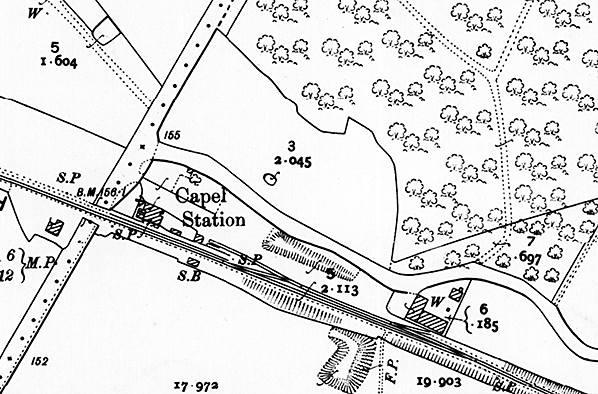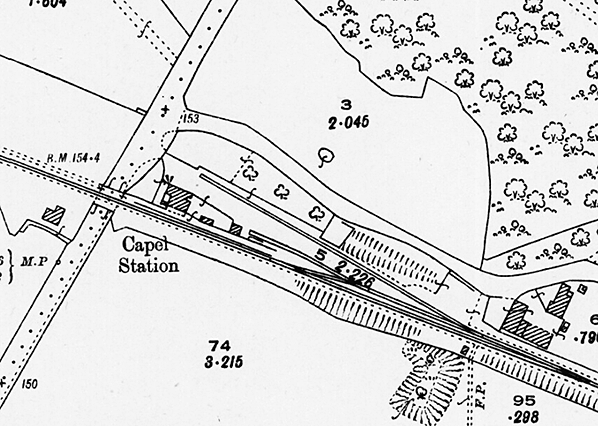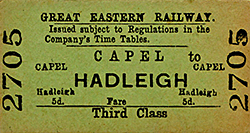
Station Name: CAPEL[Source: Nick Catford]
Capel Station Gallery 1: 9 June 1956 - c1960 old4.jpg) On Saturday 9 June 1956, Class J15 0-6-0 No.65459 is about to cross the road at Capel with an enthusiasts’ special comprised of three goods brake vans. By this date the branch goods did not operate on Saturdays and Capel was to close to all traffic on and from 13 July 1964, nine months before the branch closed entirely. Just visible at far left is a level crossing gate, with the road being the then single carriageway A12; today a busy section of dual carriageway with what is now the Capel St. Mary bypass commencing a short distance to the right. The gentleman on the right with bowler hat may have been a railway official. The enthusiasts’ special is somewhat mysterious. It was organised by either The Railway Club (long since defunct) or the Railway Enthusiasts Club, beginning and ending at Liverpool Street. The route was Liverpool Street to Hadleigh via Audley End - Saffron Walden - Bartlow - Colchester - Ipswich & Bentley. Tickets were printed 'Day Excursion' along with the route as described, return being direct from Bentley to Liverpool Street. The inclusion of 'Ipswich & Bentley' is revealing; it tells us the passengers would pass through Bentley on their way to Ipswich before returning to Bentley for the Hadleigh branch. Ipswich is where they boarded the brake vans behind the J15. The circuitous journey from Liverpool Street to Ipswich would not, given the small number of passengers involved, have warranted a special passenger train so it is highly likely this leg was undertaken by timetabled trains, as was the return to London from Bentley. Indeed, at least one person recalls this as being the case. Another obscure detail is the route taken between Haverhill and Chappel, which could have been via Halstead or Sudbury. Despite these uncertainties necessitating a degree of detective work, no doubt a jolly day was had by alll.
Photo by RC Riley  
1904 1:2,500 OS map clearly shows the layout of the station and goods yard. The station is accessed from a small forecourt off the A12 road. The station building incorporating the station master's house is seen with the station garden immediately east of the house. There is a small goods yard comprising a loop siding and another siding running behind the east end of the platform to a short dock. The small building at the end of the siding is the goods shed; the other building at the back of the platform may have been a lamp room. The coal siding is not shown on this map. The signal box is opposite the platform.
 old2.jpg) Capel station was accessed from a small forecourt off the A12. The entrance to the booking hall is on the left with the door to the station master's house through the porch. The poster on the notice board states Capel Station open for goods and parcels traffic only.(April 1956). Capel station was accessed from a small forecourt off the A12. The entrance to the booking hall is on the left with the door to the station master's house through the porch. The poster on the notice board states Capel Station open for goods and parcels traffic only.(April 1956).Copyright photo from Stations UK old3.jpg) In April 1956 the station had been closed to passenger traffic for 14 years but remains largely unchanged apart from the removal of signs and notice boards. The wall extending from the station building runs along one side of the station master's garden. The room behind the wall might be a lamp room. Note the fire buckets hanging on the wall.
Copyright photo from Stations UK old3a.jpg)
Capel station looking south-east from the level crossing towards Bentley in April 1956.
Copyright photo from Stations UK
old3b.jpg) Capel looking towards Bentley in April 1956. A number of open wagons stand on the siding, which was double-ended and thus effectively formed a loop. One set of points is adjacent to the furthest visible wagon, the other near the tall tree centre distance. Shadows create an illusion of the running line curving sharply to run alongside the station platform. The white bracket supported a loading gauge but it is not clear if the actual gauge was still present at this time. To the right of the running line and opposite the shed doors can just be discerned the track for storage of a PW motor trolley, while at bottom right the clearer patch of ground was, or was roughly, where the signal box once stood and appears to be in use as some sort of garden. Capel signal box had been abolished by the LNER in April 1923.
Copyright photo from Stations UK old3d.jpg) The 30 September 1956 Suffolk Venturer railtour of the Railway Enthusiasts Club crosses the A12 at Capel on its way to Hadleigh. This was reputedly the first passenger train on the Hadleigh branch since withdrawal of the passenger service in 1932, but this is unconfirmed. The train comprised five ex-LNER Gresley coaches of which one was a cafeteria car, a relatively rare breed converted from existing stock of which some had been staff accommodation for ambulance trains. Waiting at the level crossing, left, is a Standard 8 and a Bedford OY lorry. Between these vehicles is what appears to be a bufferstop but why it was there is unclear as no record has been found of a siding extending to this point. The locomotive is Class E4 2-4-0 No. 62797. At the time of this photograph she was a Lowestoft locomotive. New to service in 1902 as GER No. 1259, she was withdrawn from Cambridge shed in March 1958.
Photo from James Lake old1.jpg) Capel station looking towards Hadleigh on an unknown date. The wall fronting what once constituted Capel's goods shed has been partially demolished, the ornate design having originally been symmetrical. Photographs from 1956 (above) show this wall intact, so the alteration occurred sometime subsequently. Photographs from 1962 show the level crossing gate nearest the camera had been replaced by a much simpler gate, no doubt due to mishaps involving road vehicles, thus we can only date this photograph to the 1956 - 1962 period. At this time Capel station was still open to goods traffic, this ceasing on 13 July 1964. On the right was a goods dock and visible is the buffer beam formed of old rails - a once common sight. The photographer was standing where Capel signal box once stood; this had a Dutton 20-lever frame, as did the box at Raydon Wood, and was abolished by the LNER in April 1923. For many years a signal box stood in the garden of a house in Capel St Mary; this was not the former Capel box as some assume but that from Raydon Wood and it is now at Bressingham Museum. The rails to the left of the running line were for storing a motor trolley used by the PW gang. These small lightweight trolleys, usually by Wickham, were manhandled on and off the track. Often, but by no means always, a small hut was provided for the trolley but it is unclear if this was ever the case at Capel as photographs, rather unclear, appear to show the trolley simply stored in the open air.
Photo from John Mann collection old8.jpg)
East Anglia had been the first area of the country to set about eliminating steam traction and during BR's somewhat messy initial application of diesel traction the region hosted a surprisingly large array of both shunting and main line types, more so in the parts of the region closer to London. Staying with the Ipswich area, the Hadleigh branch was one of many branch lines to see the BTH Type 1 (Class 15), Derby/Sulzer Type 2 (Class 24), Brush Type 2 (Class 30/31), North British Type 2 (Class 21). Others, such as the Types 3 and 4, were largely found on main line work. Unlike other branch lines, the Hadleigh branch is never known to have worked by diesel shunters, probably because of the main line stretch between Bentley and Ipswich. In this fairly well-known scene, the Hadleigh goods is seen crossing the A12 at Capel on its way back to Bentley behind an unidentifiable Derby/Sulzer Type 2. Ipswich shed had several of these locomotives on its books between 1959 and 1967, many being there from new only to be sent elsewhere before returning to Ipswich until the type left East Anglia, allocation wise, for good in 1967. The example seen at Capel lacks yellow warning panels, suggesting the period was quite early in the diesel era so 1959 - 1962 perhaps. The lorries block our view of the large rectangular notice fixed to them announcing 'STOP'. Of the two lorries that nearest the camera, carrying what looks like bags of cement, appears to be a Foden S21 by the style of its cab. The estate car is a Hillman Minx Mk VIII and its registration number tells us it was first registered in Norwich during November 1955. Like the Morris Minor Traveller and the various types of Mini estate, the use of double rear doors on estate cars was evidence of their van-derived origins and it never looked quite right on the Hillman estates. With the A12 now dual carriageway at this point and Capel station no longer in existence, this scene has change beyond recognition - see later photographs for a comparison
Photo from James Lake collection. Click here for Capel Station Gallery 2:
|
/route_map.gif)

 The crossing gates were initially opened and closed by station staff, usually the porter and later the porter-signalman. After 1923, the foreman-in-charge of the station was responsible for releasing the gate mechanism by means of a lever on the ground frame and then opening and closing the gates. The station was then operated on a single shift basis to reduce costs; the trainmen were thereafter responsible for opening and closing the gates when working early morning or late evening services. In the final years they operated the gates for all trains when station staff were withdrawn in 1958
The crossing gates were initially opened and closed by station staff, usually the porter and later the porter-signalman. After 1923, the foreman-in-charge of the station was responsible for releasing the gate mechanism by means of a lever on the ground frame and then opening and closing the gates. The station was then operated on a single shift basis to reduce costs; the trainmen were thereafter responsible for opening and closing the gates when working early morning or late evening services. In the final years they operated the gates for all trains when station staff were withdrawn in 1958
 Home Page
Home Page